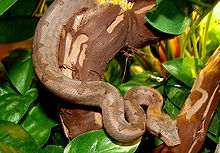Candoiinae
| Candoia | |
|---|---|
 |
|
| Pacific boa, C. carinata paulsoni | |
| Scientific classification | |
| Kingdom: | Animalia |
| Phylum: | Chordata |
| Class: | Reptilia |
| Order: | Squamata |
| Suborder: | Serpentes |
| Family: | Boidae |
| Subfamily: | Candoiinae |
| Genus: |
Candoia Gray, 1842 |
| Synonyms | |
|
|
Candoia is a genus of non-venomous boas found mostly in New Guinea and Melanesia. Four species are currently recognized. Common names include: bevel-nosed boas, keel-scaled boas.
Member species of the genus Candoia typically have a rounded and heavy body, with a flattened triangular-shaped head, and an upturned nose. Colors and patterns vary greatly, but most are various shades of brown to black. Species can vary in adult size from 60 cm (24 in) to 1.8 m (5.9 ft) in total length (including tail). Males are typically smaller than females and can be distinguished by their prominent cloacal spurs.
Species of the genus Candoia are found from Samoa and Tokelau west through Melanesia to New Guinea and the Maluku Islands.
All species of Candoia are primarily nocturnal.
The primary diet of Candoia species consists of frogs and lizards.
In the genus Candoia breeding occurs early in the year, typically after rains. Several males will approach and pursue a single female, though, there is no combat between the males. Females seem to only ovulate once every two or three years and give birth to litters averaging 10 or so neonates. The Solomon Island ground boa, C. paulsoni, is an exception as it is known to have particularly large litters, occasionally producing 30 or 40 small neonates.
Snakes of the genus Candoia are frequently imported for the exotic pet trade, but are now being bred in captivity with some regularity by private individuals. Their small size and ease of care make them interesting captives, but wild caught specimens are not known to acclimate well. The stress of captivity manifests itself in the form of lack of interest in food. Their natural diet often presents a problem for hobbyists mainly familiar with using rodents as food.
*) Not including the nominate subspecies.
T') Type species.
...
Wikipedia
